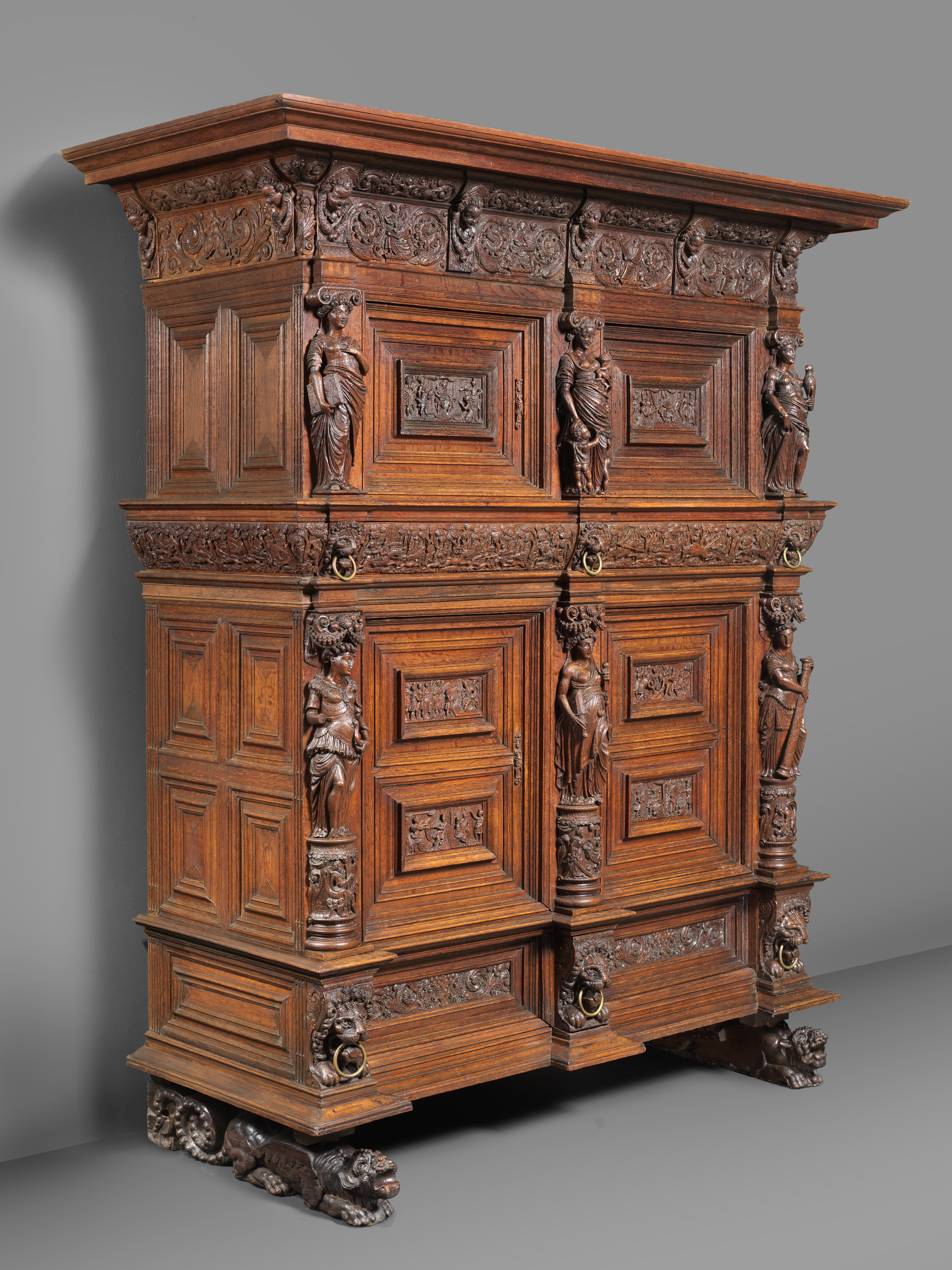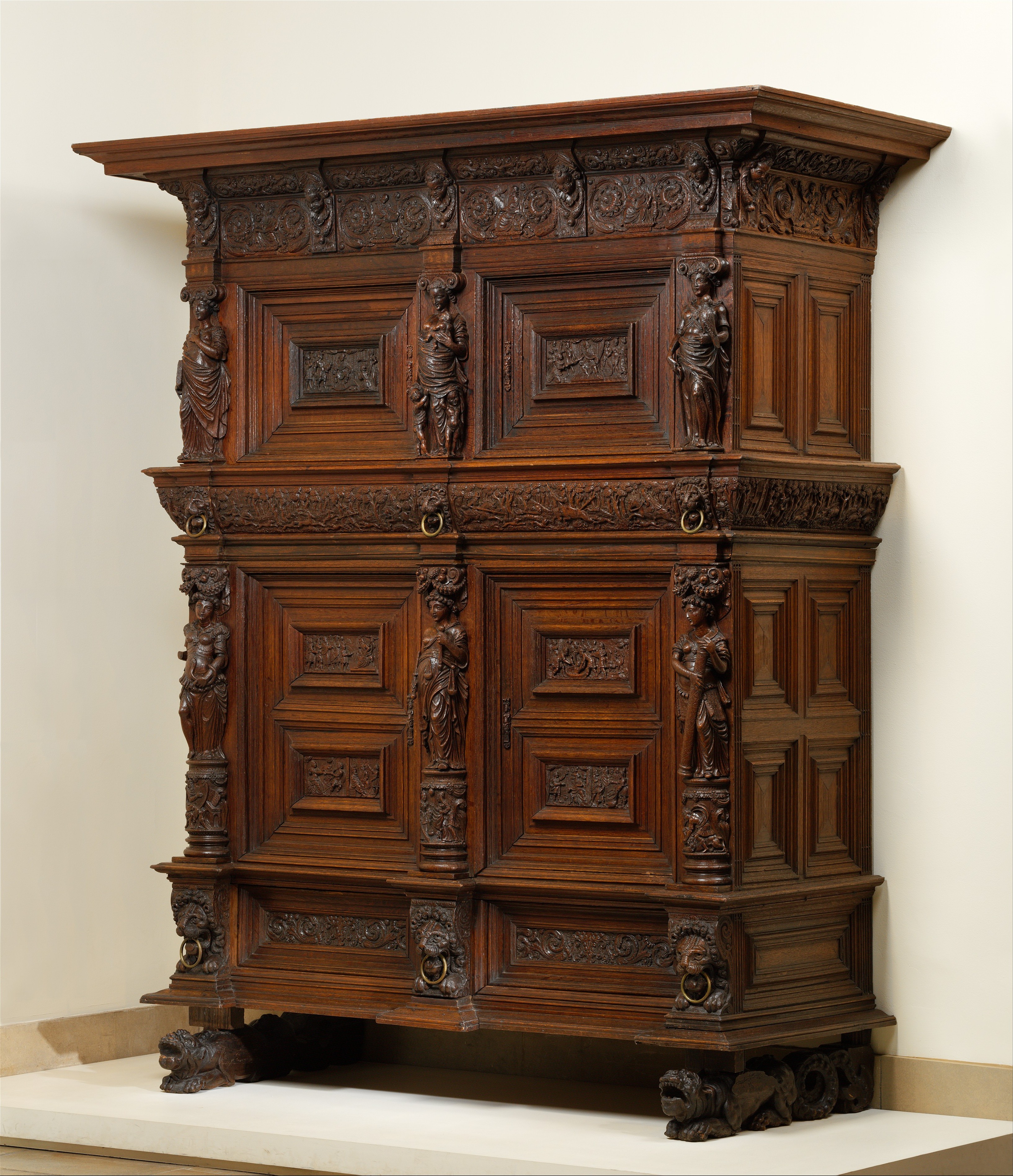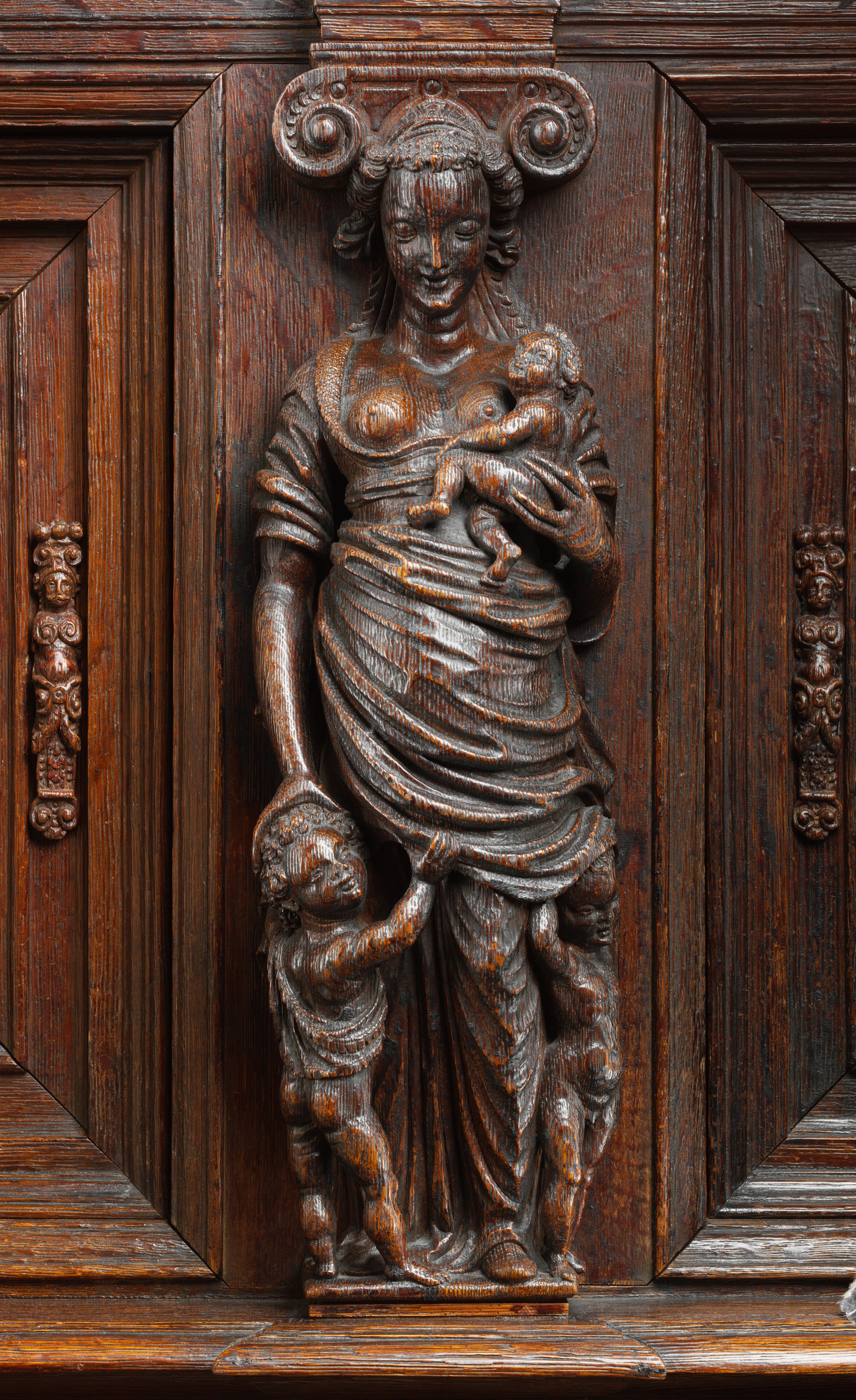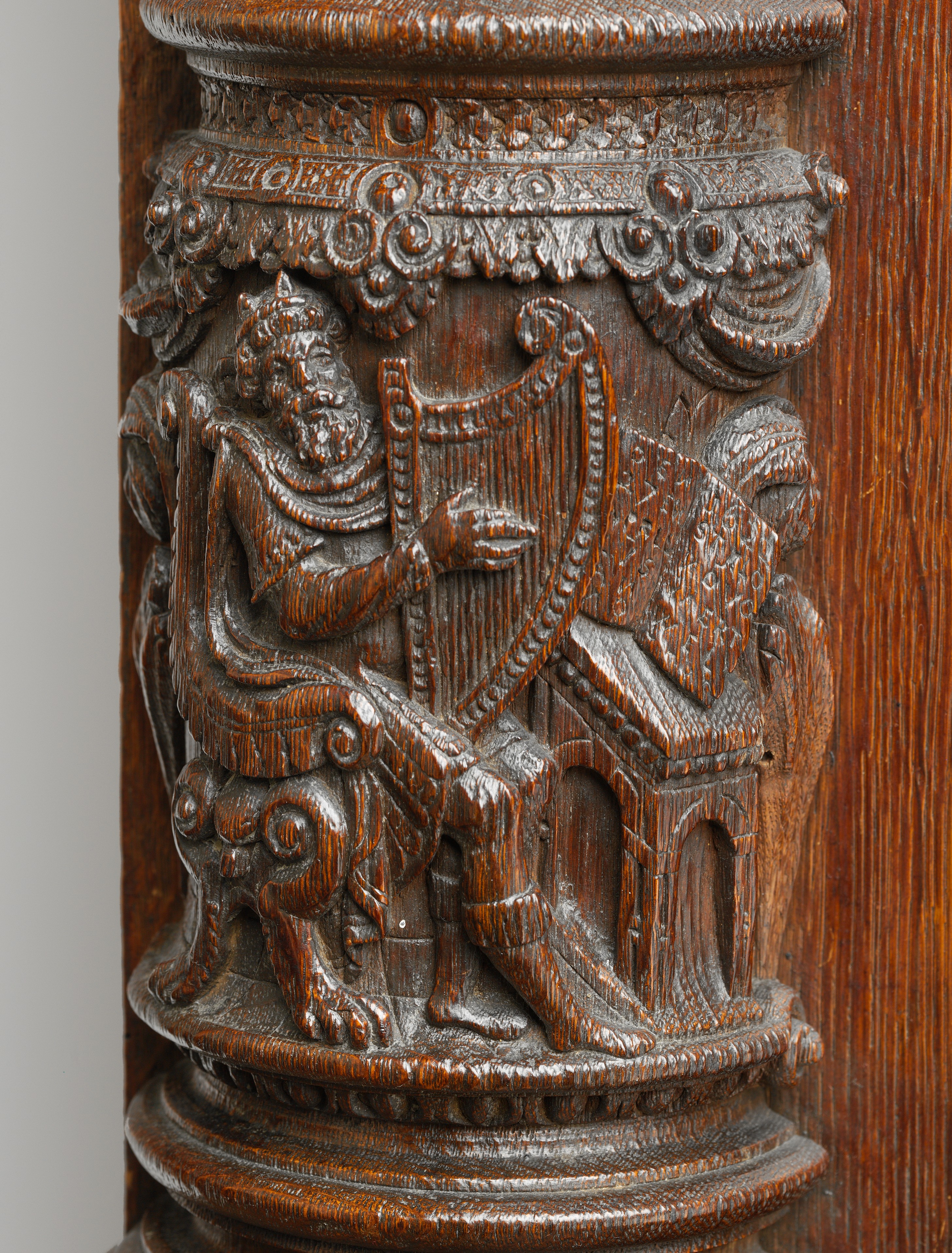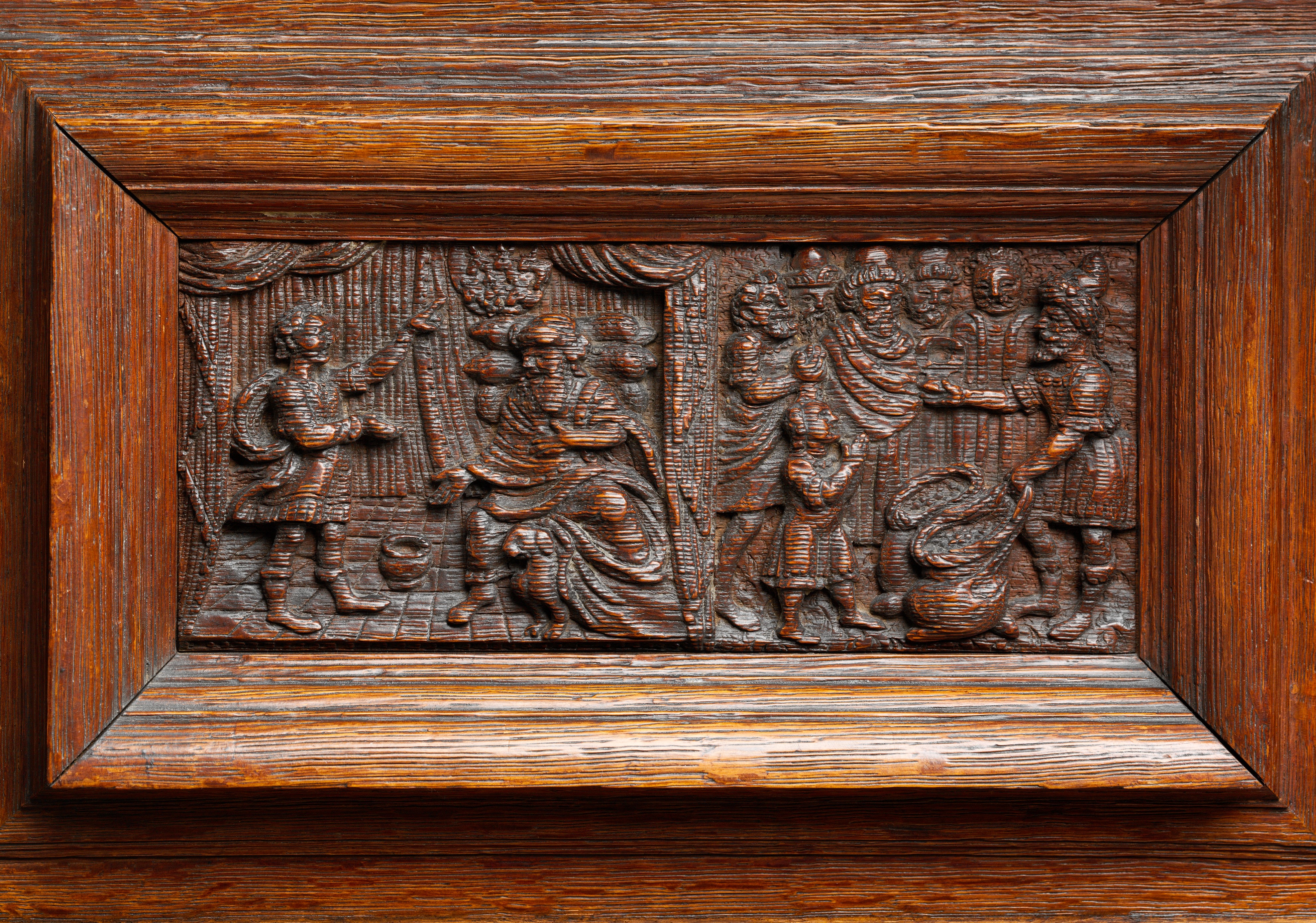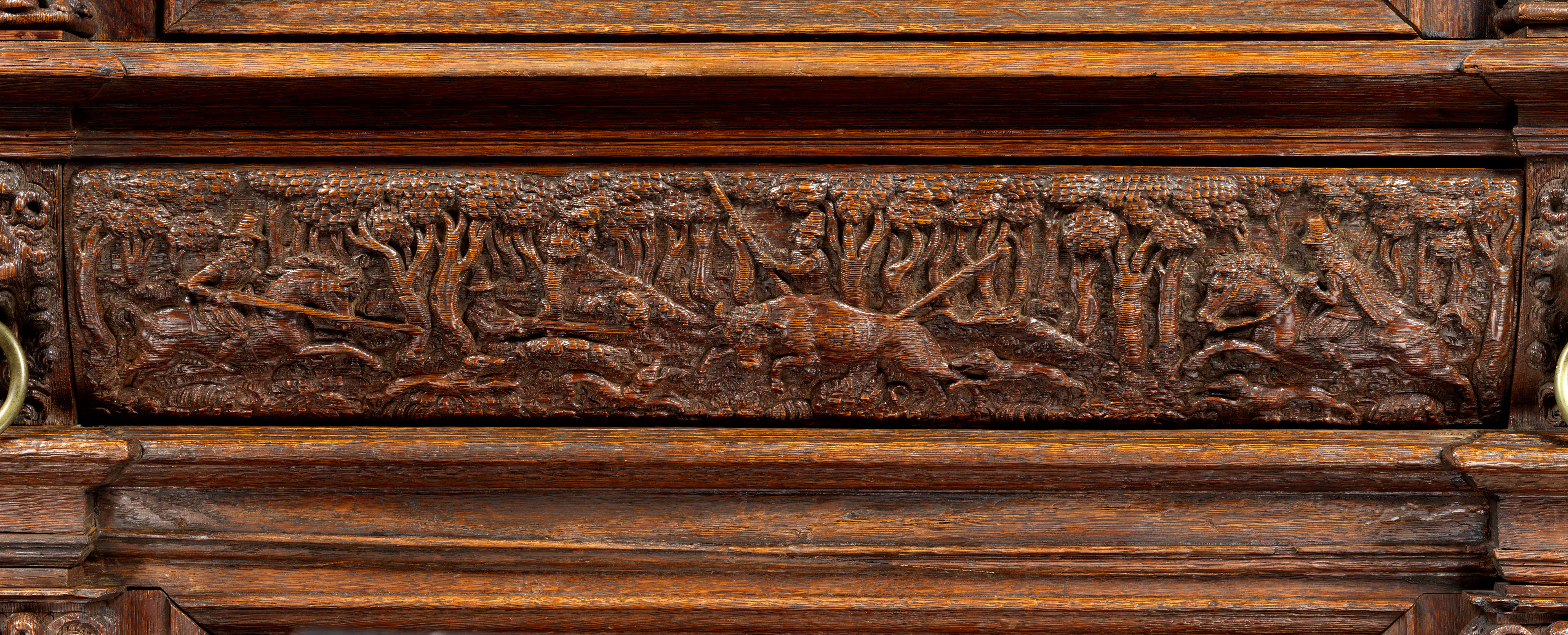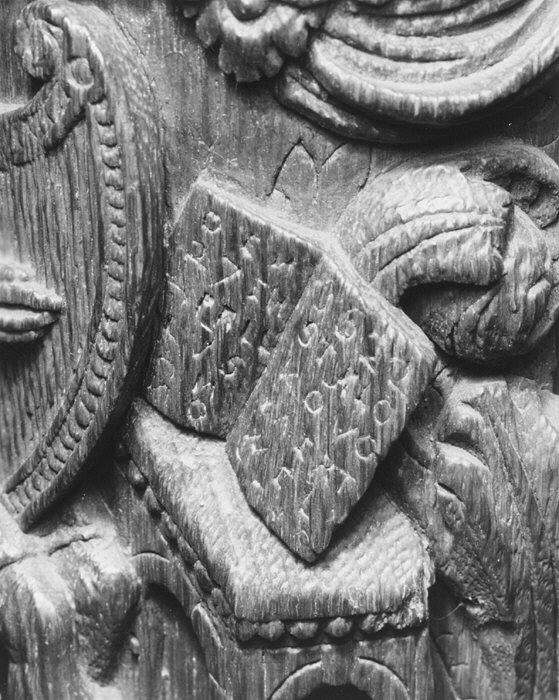Cupboard (Beeldenkast)
Monumental cabinets of this type, known in modern Dutch as beeldenkasten (cabinets with figures) in reference to the usually female caryatids carved on them, were among the most costly and impressive pieces of furniture made in the Northern Netherlands during the first half of the seventeenth century [1]. Architectural in structure, this four-door example consists of a base and two main sections topped by a broad frieze and a protruding cornice. A large drawer with a convex front forming a second frieze separates the upper part from the one below. The base, also fitted with a drawer, is raised off the floor by two dragon-shaped supports. [2] The entire cabinet is richly decorated with exquisite carving, especially on the front, which is embellished by six caryatids supporting Ionic capitals. From left to right, flanking the doors in the upper register are the three Theological Virtues: Hope with a book, Charity with three infants, and Faith with an anchor and a dove. Three of the four Cardinal Virtues- Prudence with a snake, who probably held a mirror in her missing hand, Justice with a sword and scales, and Fortitude with a pillar-flank the doors from left to right in the lower register. The drums underneath the feet of the three Cardinal Virtues are carved with figures from the Old Testament. They are, again from left to right, King David playing the harp, Judith handing the head of Holofernes to her maidservant, and Samson slaying the lion by breaking its jaw. The sides of the cabinet display vertical panels. Framed by moldings, the center of each panel is composed of three pieces of oak. The pieces at top and bottom are triangular, creating the illusion of depth. The door panels on the front are oriented horizontally and decorated with biblical stories. The single panels in the upper section are devoted to the judgment of Solomon and Queen Esther kneeling before her husband, the Persian King Ahasuerus. [3] Episodes from the life of Joseph are rendered on the double panels of the lower doors. The top two show, from left to right, the young Joseph relating his dreams to his father and brothers, and Joseph being lifted from the pit and sold into slavery. Those below are divided into two scenes each: the one to the left depicts Joseph fleeing Potiphar's wife and Joseph in prison, explaining the dreams of Pharaoh's butler and baker. The panel on the right illustrates Joseph interpreting Pharaoh's dreams and the episode when Joseph's silver cup is found in his brother Benjamin's corn sack.
The frieze that runs along the facade and sides of the cabinet beneath the cornice is divided into six sections by modillions carved with a winged angel's head. Depicted on the front are the Four Evangelists with their symbols and their names inscribed between large foliated scrolls. On the left can be seen Phyllis riding on the Greek philosopher Aristotle's back, and on the right Delilah is holding shears to cut locks of hair from Samson's head. Different hunting scenes, which seem to be purely ornamental, are rendered on the convex frieze below. On the left side of the cabinet hares are chased by hounds. The quarries on the front are stag and ox. These scenes are separated by three lions' heads, each with a ring in its mouth; the one in the center serves as a drawer pull. A boar is hunted on the cabinet's right side. The carved scrolls and fruit baskets on the drawer front in the base create a certain trompe l'oeil effect since the sequence is broken at the center, giving the impression that the motifs continue behind the central lion's head. [4]
Although a number of beeldenkasten have survived, few are dated. The inscription and date, 27 April 1622, on the Museum's piece make it the earliest example of certain date known to exist. [5] A special event may have taken place on that day, possibly a wedding, since such large cupboards were often commissioned for, or presented to, a bride, who would use it to store her linens. It has been suggested that the themes of their decoration are linked to marriage, since they are allegories of male and female valor and virtues. [6] Indeed, during the sixteenth and seventeenth centuries illustrations of biblical stories served as didactic examples of moral behavior and were regularly used in the Netherlands as embellishment for furniture and other objects of daily use. [7]
The Theological and Cardinal Virtues represented as caryatids might be seen as the pillars of a Christian marriage or, more generally, of a society based on the Christian creed. The judgment of King Solomon symbolized justice and wisdom, and Queen Esther's courageous intercession on behalf of her people exemplified a wife's beneficial influence within a marriage. [8] The complex story of Joseph has been said to illuminate the love of family, [9] but individual episodes could be interpreted differently. Joseph's rejection of Potiphar's wife, a beloved theme in Dutch art, may be seen as an allegory of chastity and as a warning against lust and adultery. [10] Samson in combat with the lion is readily understood as an emblem of Fortitude, under whose feet he is depicted on the cabinet. [11] Especially popular as instructive examples were the biblical heroines-the brave and chaste Judith, for instance, who saved her people by beheading Holofernes, a general who had laid siege to the Jewish city of Bethulia. But the story of Judith and Holofernes could have a different interpretation as well. In association with depictions of Delilah and Samson and of Phyllis and Aristotle, it can be seen as an illustration of a man's misfortunes at the hands of a scheming woman. [12] The inscribed book on the drum beneath King David might be a reference to the Psalms, of which he is traditionally believed to be the author.
Although it is not known who was responsible for the creation of this magnificent cabinet, it must reflect the collaboration of both a cabinetmaker and a master carver. According to guild regulations, a cabinetmaker was not allowed to execute more than the simplest of carvings. The carver of this cabinet has paid remarkable attention to minute details, such as the patterns of garments and their trim or the depiction of dreams in three of the Joseph panels. For instance, the cows that appeared in Pharaoh's first dream symbolizing seven years of plenty and seven years of famine to come can be clearly distinguished. The idea of rendering the king's dream as well as those of Joseph and of the baker and the butler in medallions above their heads must have been derived from engravings. [13] Probably all these representations were adapted from popular print sources or Bible illustrations. Some of the scenes in the panels, such as that of Jacob interpreting Pharaoh's dreams are related to compositions by the Haarlem painter and draftsman Maarten van Heemskerck (1498-1574), who produced numerous designs for prints with subjects from the Old and New Testaments.
In several ways the Museum's cabinet is different from extant beeldenkasten of later date. Two of the five modillions on the front do not correspond to uprights below and therefore make little sense in architectural terms. In later cabinets there are usually only three such carved brackets and they are placed directly above the caryatids. Whereas cabinets of this type are generally supported on ball feet, this example has dragon's feet, which appear to be related to the fanciful creatures seen in furniture designs by Hans Vredeman de Vries (1527-1604) and his son Paul (1567-after 1630). [14] The fact that an episode from the life of Queen Esther is depicted also attests to the early date of the Museum's piece. Esther's popularity as one of the Old Testament heroines waned in the Netherlands during the early seventeenth century in favor of the chaste Susanna. A number of beeldenkasten of a slightly later date are decorated with carved scenes of Susanna. [15]
Beeldenkasten are traditionally thought to have originated in the western coastal region of the Netherlands called Holland; [16] however, since a substantial number of examples displaying carving of varied quality is known today, it is likely that the type was fashionable from the outset in other areas of the country as well.
The cabinet is first recorded in the collection of D. G. Bingham of Utrecht, whence it was sold at auction in 1923. [17] Bought at that sale by the Amsterdam dealer Étienne Delaunoy, the cabinet was acquired at an unknown date by the newspaper magnate and collector William Randolph Hearst (1863-1951). [18]
Footnotes:
[1] See Baarsen 1993b and Reinier Baarsen's entry in Luijten et al. 1993, pp. 415-06, no. 73
[2] When the cabinet was acquired by the Museum, it had three dragon supports. The central one was removed because it was considered to be a later addition.
[3] This scene was long though to depict the Queen of Sheba's visit to Solomon, but the fact that the king is extending his scepter to the kneeling woman makes it clear that he is Ahasuerus, forgiving Esther for entering his present withought having been summoned; see Veldman 1993, pp. 133, 136, no. 155/1.
[4] Baarsen 1993b, p. 208.
[5] footnote: the date "DEN 27 In aprilis anno 1622" is followed by the words, partly in Latin and partly in Dutch, "STILO NOVO VAERT WEL," meaning "in the style, fare well." "In the new style" probably refers to the change made in 1582 from the Julian to the Gregorian calender, which was accepted at different times by different countries. In the Julian calender (old style) the date would have been 12 April 1622. Related beeldenkasten decorated with six caryatids are known, but none is dated. See, for instance, Haags Gemeentemuseum 1975, no. 5; "Nederlandse Kunst- en Antiekbeurs" 1979, p. 634; and Glemming 1992, p. 2372.
[6] Lunsingh Scheurleer 1961, p. 46; and Baarsen 1993a, pp. 24-25, no. 9
[7] See the catalogue of an exhibition in Utrecht devoted to this topic: Koote 1991.
[8] Brooke 1992, p. 53
[9] Baarsen 1993b, p. 207. A cabinet with scenes from the life of Joseph in the Gemeentemuseum, The Hague, is illustrated in Haags Gemeentemuseum 1975, no. 5. Another, in the Museum für Kunst und Gewerbe, Hamburg, is illustrated in Feulner 1980, pl. 232.
[10] Maarten van Heemskerck used this theme as an illustration of the Tenth Commandment: You shall not covet your neighbor's servant. See Brooke 1992, pp. 20-21.
[11] Hall 1979, pp. 271-72.
[12] Ibid., pp. 31, 181, 272.
[13] See, for instance, Thesaurus Sacrarum Historiaru Veteris Testamenti, published by Gerard de Jode (Antwerp, 1579), pls. 92,95,96.
[14] Jervis 1974b, nos. 149, 154, 328, 330-31.
[15] Kootte 1991, p. 49, fig. 46, p. 89, no. 43; anbd Velman 1991, pp. 40-41.
[16] tnote: This idea is based on the act that one cabinet was made at Hoorn. The resemblance of the female caryatids on the pulpit of the Nieuwe Kerk in Amsterdam, carved in 1648-49 by ALbert Vinckenbrinck (1604/5 - 1664/65), has further strengthened this theory. See Luijten et al. 1993, p. 416, no. 73 (entry by Reinier Baarsen).
[17] Frederik Muller et Cie., Amsterdam, 26-29 June 1923, lot 626.
[18] It was sold from Hearst's collection at a sale at Hammer Galleries, New York, in 1941, lot 126-1
Due to rights restrictions, this image cannot be enlarged, viewed at full screen, or downloaded.
This artwork is meant to be viewed from right to left. Scroll left to view more.


